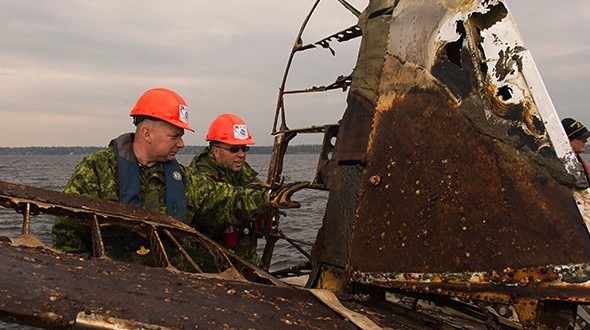Lake Muskoka, near Gravenhurst, Ontario, is yielding up a 70-year-old secret.
Canadian Armed Forces personnel began bringing the Royal Canadian Air Force’s Northrop Nomad aircraft #3521, which crashed in the lake on December 13, 1940, to the surface.
As pieces of the aircraft were revealed to the light of day, those working at the crash site paused for two minutes of silence in remembrance of the two airmen – Lieutenant Peter Campbell of the Royal Air Force and Leading Aircraftsman Theodore (Ted) Bates of the Royal Canadian Air Force (RCAF) – who died in the crash.
The Royal Canadian Navy’s Fleet Diving Unit (Atlantic), located in Halifax, Nova Scotia, recovered the remains of the fallen airmen in October 2012; the airmen were interred a year later with full military honours.
The RCAF is leading the recovery operation, which began on Saturday, October 25 and is expected to last approximately 10 days. The RCAF has partnered with the Royal Canadian Navy, the Directorate of History and Heritage at the Department of National Defence, the Ontario Provincial Police Bracebridge Detachment, the National Air Force Museum of Canada, located in Trenton, Ontario, and the Canadian Coast Guard. Notable support also came from the towns of Gravenhurst and Bracebridge, and the Lost Airmen of Muskoka Project.
The main recovery effort for Nomad #3521 is supported by a recovery and salvage team from the RCAF’s Aerospace and Telecommunications Engineering Support Squadron based at 8 Wing Trenton, Ontario, with critical diving support from the Fleet Diving Unit (Atlantic).
The wreckage will remain the property and responsibility of the Royal Canadian Air Force until the full recovery is achieved, after which the aircraft will be handed over to the National Air Force Museum of Canada.
The Royal Canadian Air Force will hand the aircraft over the the National Air Force Museum Monday at the Pride of Muskoka at 10:00 a.m.
Agencies/Canadajournal/Press Releases
 Canada Journal – News of the World Articles and videos to bring you the biggest Canadian news stories from across the country every day
Canada Journal – News of the World Articles and videos to bring you the biggest Canadian news stories from across the country every day



